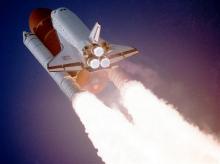With the controversial shut-down of NASA's 30-year old space shuttle program it is undoubtedly the end of an era. Some call it indicative of the U.S. "brain-drain"; a process of slowly losing our capacity for technological innovation and a sign that we will be passed by as leaders of progress. Others call it necessary to open the door to more intensified and entrepreneurial innovation by private industry. Whatever your take, there's no doubt the the closing of the space shuttle program will be a hard transition for many that grew up, like myself, watching those magnificent shuttles taking off and talking about the heritage of pioneering that is our national legacy, both in space and on terra firma.
The biggest losers in the decision to close the program are Texas, whose space control center in Houston will lose up to 4,000 jobs upon Atlantis' return, Florida, where the famous Kennedy Space Center will lose an estimated 5,400 jobs, and Louisiana, where the shuttle assembly plant will lose around 900 jobs. Of course, one of the unremarked losses will come in the absence of "space tech" that has filtered, over the decades, into our own commercial economy. Many of these we take for granted, but they were first developed for our astronauts and shuttles. This according to Popular Science.
1) Nutritionally-fortified supplement in baby formula - found in almost all baby formula, this algae-based supplement contains nutrients previously only found in breast-milk that are necessary for development of fatty tissues in the eyes and brain. Developed to fight atrophy in astronauts, it's nonetheless become commonplace for baby formula.
2) Goodyear Tires - Having collaborated several times with NASA, Goodyear has made a few innovations commercially accessible. A new fibrous material that makes their tires life extended up to 10,000 miles beyond that of a traditional radial tire was developed with NASA. The most recent collaboration was on a "spring-loaded" tire that keeps it's shape temporarily upon a puncture or other deflation, allowing consumers to get to an auto shop rather than wrenching an elbow on the side of the interstate.
3) Jaws of Life - This extraction equipment for emergency responders in removing passengers from structurally compromised vehicles in an accident was actually developed from NASA. It requires no power-source, cumbersome hoses, or tubes and is, according to the article, 70% cheaper than competing equipment. It was developed from the apparatus that is used in the shuttle to separate it from the spent solid fuel tanks once it reaches orbit.
4) Insulation - Aerogel was originally used by NASA in their space shuttles to keep the frigid cold of the vacuum of space from seeping through the shuttle's hull, maintaining a comfortable temperature within for the astronauts. Aerogel has been available for a few years commercially as home insulation, and is many times more efficient at trapping heat than traditional fiberglass insulation. In addition, the thermal shielding insulation in the shuttle to protect astronauts from the intense heat of the rockets is used in NASCAR to protect drivers from the heat of their massive engines.
5) Artificial Heart Pump - Dr. Michael DeBakey developed a tiny pump for the shuttle's fuel injection system that was less than 1-inch in diameter, contained only one moving part, had no shaft seals, and required very little energy to operate. This made it ideal for both use in a space shuttle and use in the human body. With minor alterations, the pump has been adapted for use in humans, and to date has saved over 200 lives.
Read more of the NASA shuttle program's contributions to regular Americans lives here.
It remains to be seen what the impact of the end of this era of space exploration will bring. What is certain is that NASA will continue to pioneer in space technology, including unmanned spacecraft. It is already developing, in conjunction with SpaceX, a new rover to be sent to Mars for further exploration. In addition the shuttle budget will be reallocated to increase funding for other NASA departments. These areas include: climate science research (which receive the largest appropriation), exploration tech, planetary science, space tech, and robotic missions. However, until other private industry or private/public collaborations can begin to develop the serious tech, funding, and interest it needs; we will be beholden to other nations to provide our astronauts with shuttles to reach beyond low-orbit. Until that time comes; look forward to a few more commercial hand-me-downs, and a lot of pictures of Mars crust.
